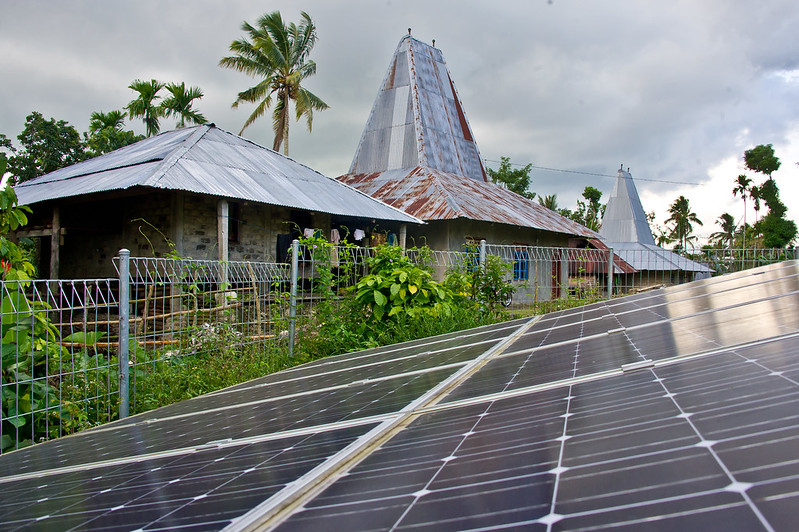James Guild
Energy policy in Indonesia is complex. Over the next few years the government has tasked itself with reaching 100 per cent electrification and reducing carbon emissions all while keeping energy affordable for consumers. Endowed with an abundance of energy resources including deep coal reserves, considerable renewable energy potential and natural gas and oil deposits it would seem a simple matter to develop these resources and use them to power economic growth. Any surplus could be exported to shore up the current account, while investment incentives could be designed to speed up the transition to renewable energy. But of course, the world is less than ideal.
The first complication is the vast geography of the archipelago. If you merely need to generate and transmit electricity across a single, unified land mass – like the United States or Australia – this can be accomplished through economies of scale to build high-capacity power plants and then transmitting the power to end-users. In Indonesia, thanks to its geography, this is only an option for heavily populated or urbanised areas.
It is not economically feasible to build high-capacity plants in order to electrify the archipelago’s numerous more remote areas, which have historically relied on diesel generators. And speaking of diesel, Indonesia has lately become a net oil importer - demand has risen so fast that domestic supply cannot keep up. Running a current account surplus, at least through oil exports, is no longer on the table.
The second complication is cost. The Indonesian state has a legal mandate to supply affordable energy to its citizens. But developing tens of thousands of megawatts of power, as well as expanding and managing a grid serving over 260 million people, is expensive. It requires large outlays of capital that can only be recouped gradually over many years through customer revenue.

And the state-owned electric utility, Perusahaan Listrik Negara (PLN) has little control over the retail price of electricity – what the consumer pays is mainly determined by the Ministry of Energy, often motivated to keep prices low for political or economic purposes. The same is true of fuel. When you pull up to a gas station, the price you pay at the pump generally does not reflect what it cost the state-owned oil company Pertamina to produce it.
This mandate to keep energy affordable for the consumer means that in Indonesia prices are not the product of competitive market equilibriums. They reflect a sort of political compromise, in which state-owned energy companies take losses in order to deliver a cheaper staple good. This is fine for consumers, but it makes designing and implementing long term financial strategies for the producers and the state very complicated.
This leads into a third complication, which is sustainability. If you are PLN or Pertamina and you have a mandate to keep prices low, you will probably try to do that by slashing your production costs. In PLN’s case this means sourcing electricity mainly from coal-fired power plants. Coal is cheap in Indonesia, and there is a large domestic supply.
Moreover, the government has the power to intervene in the domestic coal market and hold the price down, as it did in the run-up to the 2019 election. This forced domestic coal companies to sell a portion of their coal to PLN at a lower rate than they could have obtained on global markets. Given the mandate to provide affordable electricity, and the willingness of the state to intervene in markets and manipulate prices, it is no mystery why PLN continues to rely heavily on coal.
The cost of renewable energies is coming down, if we look at global levelised averages. But developing renewable energy at scale in Indonesia is still expensive, precisely because the market is not efficient and investors are often turned off by the unreliable regulatory architecture and the prospect of competing with state-owned giants like PLN. Despite pledges to reduce its carbon footprint and source 23 per cent of its energy from renewable sources by 2025, until these issues are worked out Indonesia’s green energy transition is likely to fall short.
And the fourth complication is politics. Over the years, reliance on fossil fuels and the huge state-owned companies that intermediate their consumption has created a deeply entrenched symbiosis between the political class and fossil fuel interests in the country. Solar and wind power may be getting cheaper, and they may be an effective way to supply power to remote areas. But as long as they remain more expensive than coal, and challenge the dominance of the coal lobby, they will likely struggle to make inroads into Indonesia’s energy supply.

The dominance of fossil fuel companies, and the central role played by PLN and Pertamina, also creates enormous opportunities for graft and overall regulatory uncertainty. While there is nothing that can be done about the geography of the archipelago, the way in which energy markets are structured and regulated, the way fossil fuels are treated and the incentives offered to private companies and investors - those are political decisions. If energy policy in Indonesia is ever going to change in a meaningful way it will require someone with the political will to make difficult decisions that challenge the status quo. For the reasons described above, market forces alone are unlikely to get it done.
In this edition
The contributions to this volume of Inside Indonesia explore various aspects of Indonesia’s energy dilemma. How to deliver reliable, sustainable energy to tens of millions of households stretched across a vast archipelago of great geographical diversity, while keeping costs low in a system that heavily favours the interests of the fossil fuel industry? That is the fundamental question at the heart of Indonesia’s energy policy.
Abidah Setyowati starts off by looking into one of the more confounding aspects of Indonesia’s energy ambitions – why hasn’t the country embraced renewable energy at scale, despite a wealth of potential resources? In the piece she emphasises that this is not merely a technical challenge, but at its heart a political one. Drawing on her fieldwork she also shows that despite the slow uptake, small-scale renewable resources deployed to power local villages can have a meaningful impact on peoples’ everyday lives.
When looking at the slow progress of renewable energy, one must also look at the flipside of the situation – what explains the dominance of coal? Eric Sasono offers some insights with an analysis of the documentary film Sexy Killers from director Dandhy Laksono. The film, which made a big splash when it debuted a week before the 2019 presidential election, traces the cosy relationship between Indonesia’s political class and the coal industry.
James Guild takes a look at the progress of Jokowi’s 35,000 MW program – an ambitious plan at the beginning of his presidency to add large amounts of capacity to the grid within only four years. The plan did not work out quite as envisioned but it nevertheless holds important lessons for understanding the complexity of energy policy in Indonesia given the political, financial and regulatory issues involved.
Regulatory architecture – and by extension, state capacity and trust in government – is another important key to decoding Indonesia’s energy dilemma. As explained by Michael Buehler, Indonesia’s upstream oil and gas sector has gone through numerous regulatory changes in recent years, none of which really improved the investment climate or curbed graft. Indeed, frequent regulatory changes often just add to the confusion. He suggests that rather than turning toward off the shelf regulatory fixes, a socio-economic approach to the issue would be more effective and could lead to grassroots calls for lasting and more equitable reforms.
The issue of whether or not people trust their government is also at the heart of the debate on use of nuclear power in the country. Nuclear power would seem to be a ready fix for some of Indonesia’s more intractable energy issues related to sustainability and energy security. Using detailed survey data, Yogi Sugiawan & Shunsuke Managi discuss some of the obstacles that stand in the way, highlighting the role of local leaders and regulatory agencies in reaching out to the community to increase awareness and trust.
Each article in this edition underscore the complexity of energy policy in Indonesia. Finding the optimal way to deliver affordable, sustainable energy to hundreds of islands in a system dominated by fossil fuel interests and beset by regulatory and governance challenges is a tall ask. To a certain extent the system that has evolved over time works – the electrification ratio has steadily pushed toward 100 per cent in recent years, and consumer prices are affordable which has always been the government’s main priority. But if the country wants to wean itself off of fossil fuels and truly reduce emissions, or make its energy markets function more efficiently, it will require real political courage and deep reforms, not just platitudes.
James Guild is an Adjunct Research Fellow at the S. Rajaratnam School of International Studies. He has a PhD in International Political Economy and writes for the Pacific Money blog at The Diplomat, covering finance, trade and economic development in Southeast Asia. Follow him on Twitter @jamesjguild or www.jamesjguild.com
